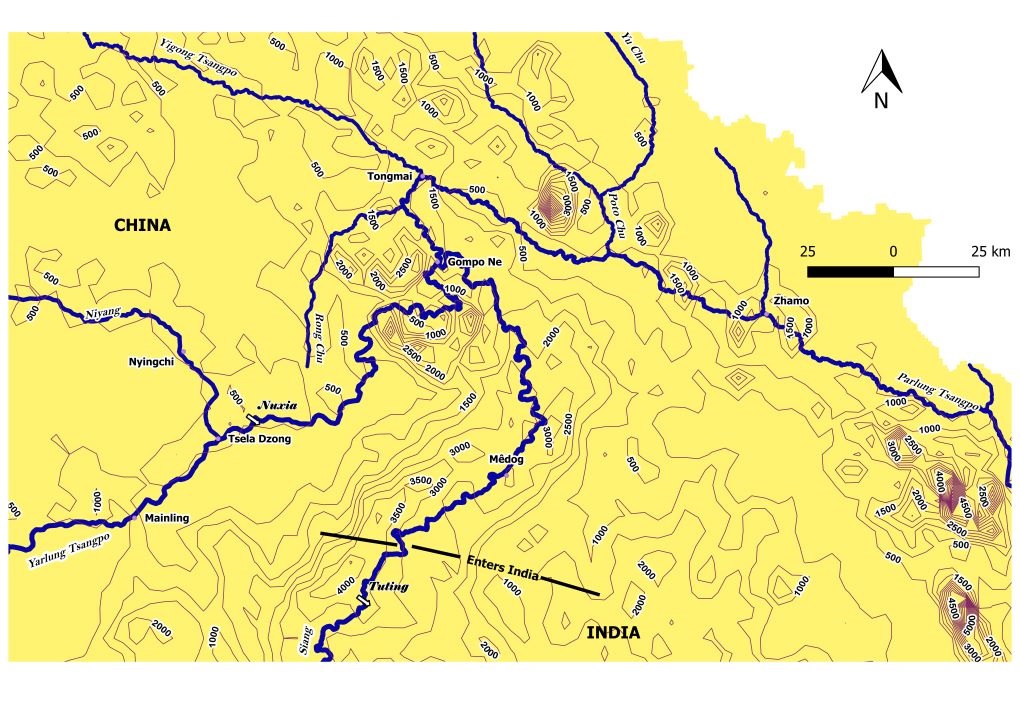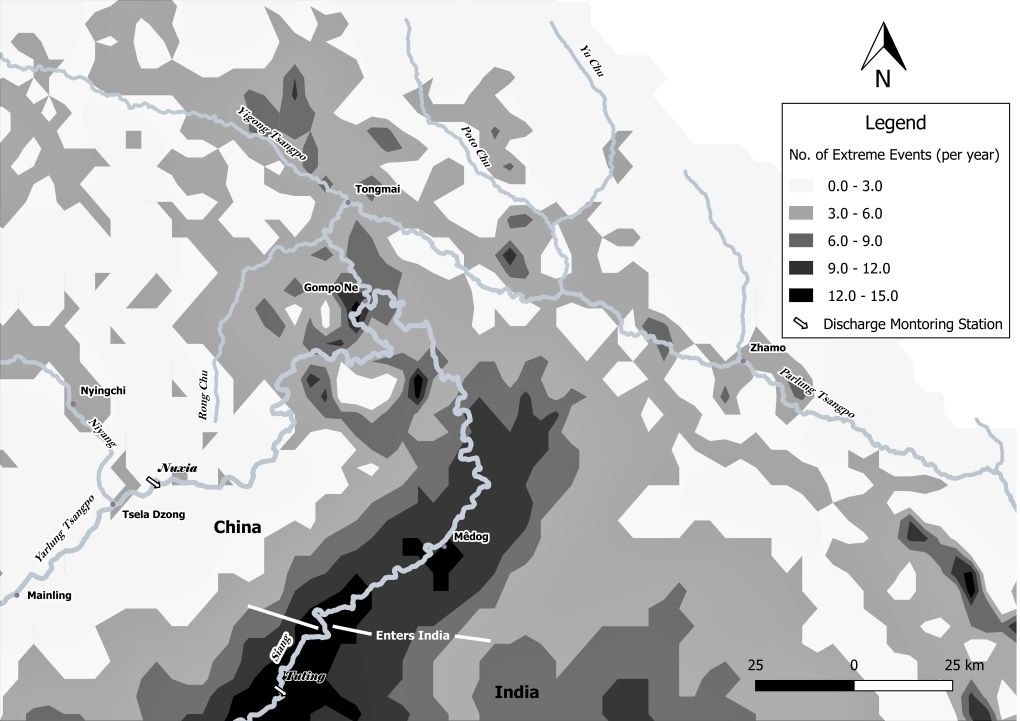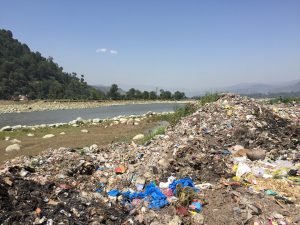China-India hydropolitical relations over the Brahmaputra have been a matter of great contention, embittered by the popular perception that Chinese interventions on the Yarlung Tsangpo (the name of the river in Tibet) can have deleterious impacts on India. This is best exemplified by the writings of Brahma Chellaney, both in his 2011 book, and in subsequent essays.
In our writings we have observed that the precipitation and flow levels in the northern Himalayan arc in the Chinese area (Tibetan Plateau) are marginal, thereby inferring that any intervention on the Yarlung Tsangpo will have potentially much less impact than perceived (See Bandyopadhyay et al 2016; Ghosh 2017; Ghosh et al 2019). There is also the silver lining – an existing Memorandum of Understanding (MoU), first signed in 2002, on the sharing of flow data on the Yarlung Tsangpo by China to India. This MoU had been renewed in 2008, 2013 and 2018 and is presently operational. The MoU is aimed at facilitating advance warning for flooding in India during monsoon.
However, we argue here that the choice of measuring stations from which the flow data is shared is inadequate as it does not consider the areas endowed with greater rainfall, located in the southern Himalayas.
The Brahmaputra, flowing through southern Tibet, northeast India, and eastern Bangladesh, and with tributaries in Bhutan, is 2,880 kilometres in length. Of that, 1,625 kilometres flows through the Tibetan plateau as the Yarlung Tsangpo; 918 kilometres flows in India as the Siang, Dihang, and Brahmaputra; and the 337 kilometres in Bangladesh (under the name of Jamuna) until it merges into the Padma near Goalando. The Brahmaputra is identified as the flow downstream of the meeting of three tributaries — namely, Luhit, Dibang, and Siang/Dihang, near Sadiya in Assam. This geographical distribution of length gives the impression that the Yarlung Tsangpo makes a substantial contribution to the total flow of the Brahmaputra, which is a myth.
Yet, this myth has trigerred the perception that Chinese interventions upstream can deplete water downstream. Allegedly, it may also be responsible for the choice of measuring stations in the Tibetan boundary in the north aspect of the Himalayan arc as mentioned in the data-sharing MoU.
![The Brahmaputra sub-basin [map prepared by authors]](https://dialogue.earth/content/uploads/2020/01/Location-Map-1.jpg)
The data sharing agreement identifies three hydrological gauging stations in Tibet for the purpose of developing an early-warning system – Nugesha, Yangcun and Nuxia. The MoU requires China to share data on rainfall, water level and discharge, primarily during the monsoon period (May 15 to October 15) when the chances of flooding are maximum. The agreement also ensures sharing of data in the non-flood season when the water levels at the designated stations are close to breaching the danger level. For its part, India is required to pay a mutually agreed sum of money for the data. It is also required to share information regarding data utilisation. The exchange works in conjunction with the establishment of an institutional mechanism, known as the India-China Expert Level Mechanism (ELM) on Transborder Rivers.
Despite the positive intentions of friendly cooperation, equality and mutual benefit, all of which are enshrined in the agreement, it seems that the primary purpose of designing an effective early-warning system is woefully lost. This is because all the three stations are located in the rain-shadow, in the north aspect of the Himalayas. A better understanding of the hydro-meteorology of the basin in general, and the region comprising the Great Bend of the Yarlung Tsangpo in particular, is necessary to improve the design of the agreement.
Understanding hydro-meteorological realities
The Brahmaputra is mostly fed by rainfall, with snow and glacial melt contributing barely 13% of the total flow of the stream as measured at Bahadurabad in northern Bangladesh. One needs to keep in mind that many of the tributaries of the Brahmaputra like Teesta, Manas, Luhit, Subansiri, and Dibang are also fed by glaciers and contribute to the total run-off of the main course. This implies that the glacial contribution to Brahmaputra’s flow by the Yarlung Tsangpo is even lower.
While precipitation is the largest contributor to the flow, rainfall is extremely varied across the basin. The Tibetan Plateau receives very little rainfall by virtue of its location on the north aspect of the Himalayan crestline. Comparatively, the rainfall in the part of the basin located in the south aspect of the crestline is much higher and the annual average precipitation (that includes mainly rainfall) may reach about 4,500 mm. This is in stark contrast to the average annual precipitation of about 300 mm in the trans-Himalaya, north of the crestline. All the three gauging stations from which India gets the hydrological data as part of the MoU are located north of the Himalayan crestline.
While much of the flow in the Yarlung Tsangpo that enters Arunachal Pradesh in India as Siang is generated in the south aspect of the Himalaya, there seems to be an absence of flow data in the stretch of the river from the crestline to the China-India border. In view of this gap, for all practical purposes, the MoU is inadequate in establishing a comprehensive early warning system downstream.
The Brahmaputra receives large components of the flow in India and Bangladesh from tributaries like Buri Dihing in the east to Teesta in the west, and gets wider and wider as it flows. This is also represented in the mean annual discharge at Nuxia (31.2 BCM) and locations further downstream – at the point where it leaves China (78.1 BCM) and Pasighat (185.1 BCM) in Arunachal Pradesh, India. According to Jiang et al (2016), while the peak flows (June-October) at Tsela Dzong and Nuxia in Tibet are about 5,000 and 6,000 cumecs (cubic metres per second), respectively, the peak flow at Pandu near Assam’s largest city Guwahati is approximately 60,000 cumecs. This brings up the question: How can a station with barely 10% of the flow and precipitation help in prediction and early warnings?
Point of interest
The moisture-bereft Tibetan Plateau is connected to the moisture-rich south aspect of the Himalayas by a corridor. This corridor extends along the Great Bend of the Yarlung Tsangpo in Tibet, and along the Brahmaputra and Siang rivers in Arunachal Pradesh. The precipitation in this corridor is quite anomalous. As per the analysis of data from the Tropical Rainfall Measuring Mission (TRMM) – a joint space mission of NASA and the Japan Aerospace Exploration Agency – patches within the corridor can experience annual rainfall which is in excess of 2,500 mm (Fig. 2). The entire corridor is located downstream of Nuxia, the last gauging station as per the MoU. Moreover, an important left-bank tributary – Parlung Tsangpo – joins the Yarlung Tsangpo downstream of Nuxia, and drains an additional amount of high-runoff into the Yarlung Tsangpo.
This entire zone within which the Yarlung Tsangpo traverses 320-odd kms between Nuxia, the last hydrological station in China, and Tuting the first hydrological station within India, is a zone from which flow-data is not available. Moreover, the chances of intense rainfall events along with landslides and avalanches induced flash flood are quite high in this area, posing a serious threat to the downstream areas in Arunachal Pradesh and Assam (see images below).


Based on the hydro-meteorological facts, it may be inferred that the choice of gauging stations is inadequate for serving the purpose of early warning. There is a need to establish gauging stations between Nuxia and Tuting for a comprehensive and effective early-warning system. In the absence of real-time flow data from the region mentioned above, East Siang district of Arunachal Pradesh becomes particularly vulnerable. This zone of vulnerability may also extend to the neighbouring districts of Dhemaji and Dibrugarh in Assam, with the travel time of flood wave from Pasighat to Dibrugarh being only 12 hours.
It is important that the institutional mechanism or ELM that already exists between the two nations be leveraged for bridging the crucial data gap that presently exists.
We suggest two locations in Tibet from where high season flow data needs to be accessed by India for early warning of untoward incidents: the first location is at Gompo Ne, at the confluence of the Parlung Tsangpo and Yarlung Tsangpo, located about 150 km upstream of Tuting (Arunachal Pradesh, India); the second gauging station for data access can be at Mêdog, at the confluence of the Chimodro Chu and the Yarlung Tsangpo, located about 50 kilometres upstream of Tuting.
If the MoU can be amended with the modifications in the choice of gauging stations, it will also improve China-India’s bilateral hydropolitical relations with respect to the Brahmaputra.
![<p>Fishermen on the Brahmaputra, a river that winds through four countries [image by: Sumit Vij]</p>](https://dialogue.earth/content/uploads/2020/01/Brahmaputra-river.jpg)
![Pakistan's National Disaster Management Authority has scrambled rescue operations in the Neelum Valley, but many people remain out of reach [image: NDMA]](https://dialogue.earth/content/uploads/2020/01/NDMA--300x99.jpg)






